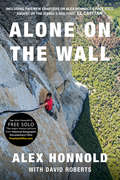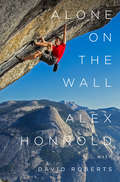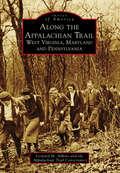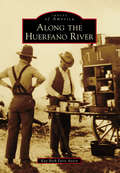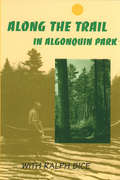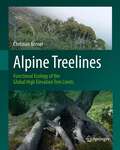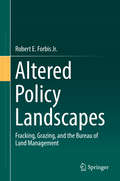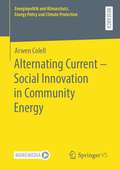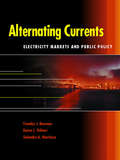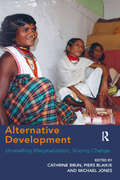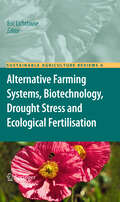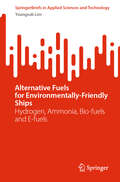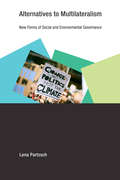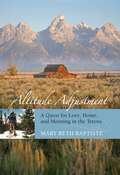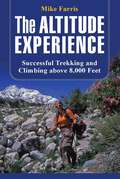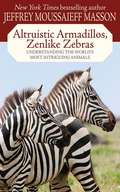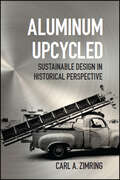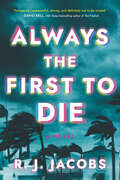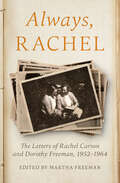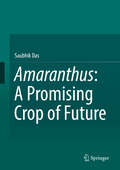- Table View
- List View
Alone on the Ocean (Fountas & Pinnell Classroom, Guided Reading)
by Catherine Friend Scott PlumbeNIMAC-sourced textbook. Stranded! Fisherman Ernie Hazard found himself all alone on the ocean in the middle of a gigantic storm. There was no one to help him survive, so he had to help himself.
Alone on the Wall (Expanded edition): Alex Honnold And The Ultimate Limits Of Adventure
by David Roberts Alex HonnoldIncluding two new chapters on Alex Honnold’s free solo ascent of the iconic 3,000-foot El Capitan in Yosemite National Park. On June 3rd, 2017, Alex Honnold became the first person to free solo Yosemite's El Capitan—to scale the wall without rope, a partner, or any protective gear—completing what was described as "the greatest feat of pure rock climbing in the history of the sport" (National Geographic) and "one of the great athletic feats of any kind, ever" (New York Times). Already one of the most famous adventure athletes in the world, Honnold has now been hailed as "the greatest climber of all time" (Vertical magazine). Alone on the Wall recounts the most astonishing achievements of Honnold’s extraordinary life and career, brimming with lessons on living fearlessly, taking risks, and maintaining focus even in the face of extreme danger. Now Honnold tells, for the first time and in his own words, the story of his 3 hours and 56 minutes on the sheer face of El Cap, which Outside called "the moon landing of free soloing…a generation-defining climb. Bad ass and beyond words…one of the pinnacle sporting moments of all time."
Alone on the Wall: Alex Honnold And The Ultimate Limits Of Adventure
by David Roberts Alex HonnoldThe life and death-defying feats of Alex Honnold, a visionary climber of the sort that comes along only once in a generation. Only a few years ago, Alex Honnold was little known beyond a small circle of hardcore climbers. Today, at the age of thirty, he is probably the most famous adventure athlete in the world. In that short time, he has proven his expertise in many styles of climbing and has shattered speed records, pioneered routes, and won awards within each discipline. More spectacularly still, he has pushed the most extreme and dangerous form of climbing far beyond the limits of what anyone thought was possible. Free soloing, Honnold's specialty, is a type of climbing performed without a rope, a partner, or hardware--such as pitons, nuts, or cams--for aid or protection. The results of climbing this way are breathtaking, but the stakes are ultimate: if you fall, you die. In Alone on the Wall, Honnold recounts the seven most astonishing climbing achievements so far in his meteoric and still-evolving career. He narrates the drama of each climb, along with reflective passages that illuminate the inner workings of his highly perceptive and discerning mind. We share in the jitters and excitements he feels waking in his van (where he lives full time) before a climb; we see him self-criticize in his climbing journal (a veritable bible for students of the sport); and we learn his secrets to managing fear--his most enviable talent. Veteran climber and award-winning author David Roberts writes part of each chapter in his own voice, and he calls on other climbers and the sport's storied past to put Alex's tremendous accomplishments in perspective. Whenever Honnold speaks in public, he is asked the same two questions: "Aren't you afraid you're going to die?" and "Why do you do this?" Alone on the Wall takes us around the world and through the highs and lows in the life of a climbing superstar to answer those fascinating questions. Honnold's extraordinary life, and his idiosyncratic worldview, have much to teach us about risk, reward, and the ability to maintain a singular focus, even in the face of extreme danger.
Along the Appalachian Trail: New Jersey, New York and Connecticut
by Leonard M. Adkins Appalachian Trail ConservancyCrossing through 14 states from Maine to Georgia, the Appalachian Trail enters New Jersey through the Delaware Water Gap, crosses New York's Hudson River, and rises over Connecticut's Lion's Head. The area is considered by some to be the pathway's birthplace, for in 1923, just two years after Benton MacKaye originally proposed the trail, the first few miles specifically constructed for the Appalachian Trail were built by volunteers in New York's Harriman and Bear Mountain State Parks. These photographs and the corresponding narrative present a historical perspective on what it took to create the trail, including the thousands of volunteers and the arduous tasks they performed, those who lived along the trail before and during its creation, the many people who have enjoyed the trail through the years, and the original routes that are no longer part of the present-day Appalachian Trail.
Along the Appalachian Trail: West Virginia, Maryland, and Pennsylvania
by Leonard M. Adkins Appalachian Trail ConservancyUnlike counterparts on other sections of the 2,180-plus-mile Appalachian Trail who could locate the pathway within national parks and forests, builders of the 270 miles of trail detailed in Along the Appalachian Trail: West Virginia, Maryland, and Pennsylvania did not have vast tracts of federal lands on which to construct the footpath. Yet they succeeded in creating a trail within many of the states' scenic areas. Hundreds of vintage photographs--provided by the Appalachian Trail Conservancy, National Park Service, state archives, and local trail-maintaining clubs--present an illustrated narrative of the Herculean work and dedication it took for volunteers to plan, build, and continue to maintain the trail in these states. Included are the glimpses of American history the trail passes by, the pathway's early (and later) supporters and hikers, and original locations that have been rerouted off of today's trail.
Along the Huerfano River (Images of America)
by Kay Beth AveryLong before English speakers set eyes upon it, the volcanic plug on the south bank of the Huerfano River was tagged with a moniker that means "the orphan." Spanish conquistadors saw it as a rock pile that God dumped in the middle of nowhere, an odd little cone far removed from the regular foothills edging the Sangre de Cristo Mountain Range. In the 18th century, this outcropping and the river that bears the same name were famous landmarks for Native American tribes, Hispanic explorers, and French adventurers. Then in the 19th century, along came US mountain men, gold-seekers, cowboys, sheep ranchers, railroad workers, town developers, and coal miners from 31 different countries, speaking 27 different languages. Counterculture revolutionaries discovered the area in the 1960s and established five separate communes west of Walsenburg. Each wave of immigrants brought new perspectives and lifestyles.
Along the Trail in Algonquin Park: With Ralph Bice
by Ralph BiceAlong the Trail in Algonquin Park has delighted thousands of readers across Canada and the United States from the time of its first publication in the summer of 1980. This is the fourth reprint of the classic work by the late legendary outdoorsman, Ralph Bice of Kearney, Ontario. The writing is vintage Ralph Bice; a combination of unequalled park knowledge, remarkable outdoor adventures and delightful rustic humour. Along the Trail was originally to have been titled "Forty Years in Algonquin Park," but by the time the book appeared, the author’s lifelong love affair with the park had exceeded eighty. In 1993, the time of Algonquin Park’s centennial, the "Grand Old Man of Algonquin" had entered his 94th year. He was to continue to live nearby his beloved park until his passing in 1997. Remembered not only for his writings, Ralph Bice is honoured by a fitting memorial to "Mister Algonquin" as Algonquin Park visitors will now discover when they enter the west side of the park. For here the lake he favoured over all others, Butt Lake, has been renamed Ralph Bice Lake.
Alpine Plant Life: Functional Plant Ecology of High Mountain Ecosystems
by Christian KörnerThis book is a completely revised, substantially extended treatment of the physical and biological factors that drive life in high mountains. The book covers the characteristics of alpine plant life, alpine climate and soils, life under snow, stress tolerance, treeline ecology, plant water, carbon, and nutrient relations, plant growth and productivity, developmental processes, and two largely novel chapters on alpine plant reproduction and global change biology. The book explains why the topography driven exposure of plants to dramatic micro-climatic gradients over very short distances causes alpine biodiversity to be particularly robust against climatic change. Geographically, this book draws on examples from all parts of the world, including the tropics. This book is complemented with novel evidence and insight that emerged over the last 17 years of alpine plant research. The number of figures – mostly in color – nearly doubled, with many photographs providing a vivid impression of alpine plant life worldwide.Christian Körner was born in 1949 in Austria, received his academic education at the University of Innsbruck, and was full professor of Botany at the University of Basel from 1989 to 2014. As emeritus Professor he is continuing alpine plant research in the Swiss Alps.
Alpine Treelines: Functional Ecology of the Global High Elevation Tree Limits
by Susanna Riedl Christian KörnerAlpine treelines mark the low-temperature limit of tree growth and occur in mountains world-wide. Presenting a companion to his book Alpine Plant Life, Christian Körner provides a global synthesis of the treeline phenomenon from sub-arctic to equatorial latitudes and a functional explanation based on the biology of trees. The comprehensive text approaches the subject in a multi-disciplinary way by exploring forest patterns at the edge of tree life, tree morphology, anatomy, climatology and, based on this, modelling treeline position, describing reproduction and population processes, development, phenology, evolutionary aspects, as well as summarizing evidence on the physiology of carbon, water and nutrient relations, and stress physiology. It closes with an account on treelines in the past (palaeo-ecology) and a section on global change effects on treelines, now and in the future. With more than 100 illustrations, many of them in colour, the book shows alpine treelines from around the globe and offers a wealth of scientific information in the form of diagrams and tables.
Altered Policy Landscapes: Fracking, Grazing, and the Bureau of Land Management
by Robert E. Forbis Jr.This book documents the United States Bureau of Land Management's (BLM) shift from a rancher-dominated agency to an energy-dominated agency. This shift is analyzed by identifying the conditions under which the expansion of hydraulic fracturing (fracking) in the Rocky Mountain West triggered a political conflict between ranching and energy stakeholder groups. Through scrutiny of federal actions and policies implemented by the Executive Branch between 2004 and 2010, the book sheds light on the emphasis of domestic energy production during this time period, and how the traditional ranching and energy alliance was split by shifting policy interests. The book is meant for policy makers, natural resource agencies, and students and researchers engaged in political science, public administration, and natural resource management. Chapter 1 introduces readers to the case study at hand, and reviews literature on public land agencies and policies. Chapter 2 summarizes the legal history of public land management by the federal government, and the conditions that caused the BLM to favor energy development over ranching in the mid-2000's. Chapter 3 details the role of the Executive Branch (Bush-Cheney administration) in affecting the BLM's domestic energy policies and resource allocation, and chapter 4 analyzes the role of subgovernments in affecting the BLM's motivations too. Chapters 5, 6 and 7 contain first-hand accounts from government officials, state petroleum associations, and ranching supported interest groups to explore the concept of subgovernment stakeholder domination in policymaking, and analyze the similarities and differences between different policy-making elites. Chapter 8 concludes the text by summarizing subgovernment theory, mapping the behaviors of subgovernment actors, and discussing the implications for future political appointees in the direction of land-management agencies like the BLM.
Alternating Current – Social Innovation in Community Energy (Energiepolitik und Klimaschutz. Energy Policy and Climate Protection)
by Arwen ColellCommunity energy projects give their own answers to the challenges of energy system change: They are social innovations. By building new relations between local economies, communities and technical infrastructures, these projects not only change the energy system but also respective power structures. Drawing on case studies from Germany, Denmark and Scotland, this book shows the importance of community ties, and shared symbols for successful processes of transformation and develops recommendations for policy decision-makers.
Alternating Currents: Electricity Markets and Public Policy
by Timothy J. Brennan Karen L. Palmer Salvador A. MartinezMany states within the U.S., and many countries across the world, are opening their electicity markets to competition. Many others are uncertain about their plans. These differences emphasize the complexities involved in the technology and regulatory structure of the electricity industry--an industry for which the introduction of market competition has been notoriously difficult. In response to these challenges, Alternating Currents provides a timely overview and analysis of the concerns facing industry regulators, legislators, and others as they consider whether, when, and how to open electricity markets. Authors Brennan, Palmer, and Martinez offer background on the history of regulatory policy and the technology for producing and delivering electric power. They then provide insights into the policy debates and economic issues involved in eleven important topics, including industry structure, system integrity and reliability, the mitigation of market power, and environmental protection. Alternating Currents describes the recent events leading to the demise of retail competition in California with the intent on drawing lessons for the future. In the end, the authors offer their perspective about what makes electricity a unique resource and how those factors make the potential conflict between competition and reliability the most pressing of the long-term concerns about the transformation of the electric power industry.
Alternative Development: Unravelling Marginalization, Voicing Change
by Piers Blaikie Cathrine BrunThis book brings together a collection of essays that discuss alternative development and its relevance for local/global processes of marginalization and change in the Global South. Alternative development questions who the producers of development knowledges and practices are, and aims at decentring development and geographical knowledge from the Anglo-American centre and the Global North. It involves resistance to dominant political-economic processes in order to further the possibilities for non-exploitative and just forms of development. By discussing how to unravel marginalization and voice change through alternative methods, actors and concepts, the book provides useful guidance on understanding the relationship between theory and practice. The main strength of the book is that it calls for a central role for alternative development in the current development discourse, most notably related to justice, rights, globalization, forced migration, conflict and climate change. The book provides new ways of engaging with alternative development thinking and making development alternatives relevant.
Alternative Farming Systems, Biotechnology, Drought Stress and Ecological Fertilisation (Sustainable Agriculture Reviews #6)
by Eric LichtfouseSustainable agriculture is a rapidly growing field aiming at producing food and energy in a sustainable way for our children. This discipline addresses current issues such as climate change, increasing food and fuel prices, starvation, obesity, water pollution, soil erosion, fertility loss, pest control and biodiversity depletion. Novel solutions are proposed based on integrated knowledge from agronomy, soil science, molecular biology, chemistry, toxicology, ecology, economy, philosophy and social sciences. As actual society issues are now intertwined, sustainable agriculture will bring solutions to build a safer world. This book series analyzes current agricultural issues, and proposes alternative solutions, consequently helping all scientists, decision-makers, professors, farmers and politicians wishing to build safe agriculture, energy and food systems for future generations.
Alternative Fuels for Environmentally-Friendly Ships: Hydrogen, Ammonia, Bio-fuels and E-fuels (SpringerBriefs in Applied Sciences and Technology)
by Youngsub LimThis book reports on current shipping and shipbuilding industries' efforts for decarbonization. It demonstrates what regulations have been made for large ships on international voyages and points to what is to change in the future. The book also quantitatively reviews the current challenges of alternative fuels such as hydrogen, ammonia, biofuels, and e-fuels, considering economics, safety, and greenhouse gas emissions assessments.
Alternatives For High-level Waste Salt Processing At The Savannah River Site
by National Research CouncilAt the request of the US Department of Energy, the Committee provides a technical review of alternatives selected by representatives of the South Carolina site for processing the high-level radioactive waste salt solutions stored there in 48 below-grade tanks. Annotation c. Book News, Inc. , Portland, OR (booknews. com)
Alternatives to Multilateralism: New Forms of Social and Environmental Governance (Earth System Governance)
by Lena PartzschAnalysis and case studies of emerging forms of private, public, and hybrid social and environmental governance.The effects of globalization on governance are complex and uncertain. As markets integrate, governments have become increasingly hesitant to enforce regulations inside their own jurisdictions. At the same time, multilateralism has proven unsuccessful in coordinating states' responses to global challenges. In this book, Lena Partzsch describes alternatives to multilateralism, offering analyses and case studies of emerging--alternative--forms of private, public, and hybrid social and environmental regulation. In doing so, she offers a unique overview of cutting-edge approaches to global governance.
Altitude Adjustment: A Quest for Love, Home, and Meaning in the Tetons
by Mary Beth BaptisteAware that her youth is slipping by, Mary Beth Baptiste decides to escape her lackluster, suburban life in coastal Massachusetts to pursue her lifelong dream of being a Rocky Mountain woodswoman. To the horror of her traditional, ethnic family, she divorces her husband of fifteen years, dusts off her wildlife biology degree, and flees to Moose, Wyoming for a job at Grand Teton National Park. In these rugged mountains, unexpected lessons from nature and wildlife guide her journey as she creates a new life for herself. Set against the dramatic backdrop and quirky culture of Jackson Hole, this beautifully written memoir is a thoughtful, often humorous account of a woman&’s bumbling quest for purpose, redemption, and love through wilderness adventure, solitude, and offbeat human connections.
Altitude Experience: Successful Trekking and Climbing Above 8,000 Feet
by Mike FarrisTHE ALTITUDE EXPERIENCE: Successful Trekking and Climbing Above 8,000 Feet (Falcon)Mike FarrisThe first comprehensive guide for climbing above 8,000 feetThe one-volume resource for any traveler who will be at high altitude for any period of time, this guide contains organized technical information from medical and science texts as well as anecdotes from real climbers who share their own experiences, in the body as well as the mind. This new book also lists preparation and training guidelines for ascending altitude, tips on how to acclimate, what to bring, how to "come down" after descent, and how to treat altitude sickness if it occurs. This is a practical guide for anyone new to such travel, as well as an up-to-date guide with new information for experienced climbers.Mike Farris is a biology professor at Hamline University and an experienced high-altitude climber who has traveled throughout North America, South America and the Himalayas. He lives in Northfield, Minnesota.
Altruistic Armadillos, Zenlike Zebras: Understanding the World's Most Intriguing Animals
by Jeffrey Moussaieff MassonFrom the elegant, lithe, and yes, friendly cheetah to the diminutive and faithful sea horse, and from the giant and surprisingly warlike hippopotamus to the majestic gorilla, animals have long fascinated humans. In this appealing book, Jeffrey Moussaieff Masson draws from his wealth of knowledge and a lifetime of fascination with the animal kingdom to present little-known facts and thorough explanations for behaviors of animals both familiar and lesser-known. Presented from A to Z, each entry is accompanied by a beautiful, full-color photograph. Readers will learn from someone who knows these animals and loves them as much as you do.
Aluminum Upcycled: Sustainable Design in Historical Perspective (Johns Hopkins Studies in the History of Technology)
by Carl A. ZimringTracing the benefits—and limitations—of repurposing aluminum.Besides being the right thing to do for Mother Earth, recycling can also make money—particularly when it comes to upcycling, a zero waste practice where discarded materials are fashioned into goods of greater economic or cultural value. In Upcycling Aluminum, Carl A. Zimring explores how the metal’s abundance after World War II—coupled with the significant economic and environmental costs of smelting it from bauxite ore—led to the industrial production of valuable durable goods from salvaged aluminum. Beginning in 1886 with the discovery of how to mass produce aluminum, the book examines the essential part the metal played in early aviation and the world wars, as well as the troubling expansion of aluminum as a material of mass disposal. Recognizing that scrap aluminum was as good as virgin material and much more affordable than newly engineered metal, designers in the postwar era used aluminum to manufacture highly prized artifacts. Zimring takes us on a tour of post-1940s design, examining the use of aluminum in cars, trucks, airplanes, furniture, and musical instruments from 1945 to 2015. By viewing upcycling through the lens of one material, Zimring deepens our understanding of the history of recycling in industrial society. He also provides a historical perspective on contemporary sustainable design practices. Along the way, he challenges common assumptions about upcycling’s merits and adds a new dimension to recycling as a form of environmental absolution for the waste-related sins of the modern world. Raising fascinating questions of consumption, environment, and desire, Upcycling Aluminum is for anyone interested in industrial and environmental history, discard studies, engineering, product design, music history, or antiques.
Always the First to Die: A Novel
by R.J. Jacobs"R. J. Jacobs is a masterful storyteller. A must read." —Alex Finlay, author of The Night Shift and Every Last FearFor fans of Riley Sager with a classic slasher twist comes a chilling thriller following a former horror movie actress who returns to the set of her most famous film…and is soon entangled in a series of terrifying events that resemble the plot of that one cursed movie.For Lexi, the Pinecrest Estate has become a place of horror. The dilapidated manor house in the Florida Keys, once the site of her teenage movie debut, is now haunted by memories. Memories of working on a legendary horror director's most famous film and of the terrible death that propelled them all to infamy. And ever since Lexi fled the Keys, she has vowed to never return.Until, years later, her daughter escapes to the Pinecrest in search of answers. Right when a Category 4 hurricane hits the southern coast.Now, Lexi is back on the ravaged island with only a few remaining behind, and soon enough, her life begins to resemble the plot of her most famous film. And this time, she's not sure who will make it out alive."An utterly unique thriller that combines horror movies, hurricanes, and deadly secrets from the past...definitely not to be missed"—David Bell, USA Today bestselling author of The Finalists
Always, Rachel: The Letters of Rachel Carson and Dorothy Freeman, 1952–1964
by Rachel Carson Dorothy E. FreemanThese letters between the pioneering environmentalist and her beloved friend reveal &“a vibrant, caring woman behind the scientist&” (Los Angeles Times). &“Rachel Carson, author of The Silent Spring, has been celebrated as the pioneer of the modern environmental movement. Although she wrote no autobiography, she did leave letters, and those she exchanged—sometimes daily—with Dorothy Freeman, some 750 of which are collected here, are perhaps more satisfying than an account of her own life. In 1953, Carson became Freeman's summer neighbor on Southport Island, ME. The two discovered a shared love for the natural world—their descriptions of the arrival of spring or the song of a hermit thrush are lyrical—but their friendship quickly blossomed, as each realized she had found in the other a kindred spirit. To read this collection is like eavesdropping on an extended conversation that mixes the mundane events of the two women's family lives with details of Carson&’s research and writing and, later, her breast cancer. . . . Few who read these letters will forget these remarkable women and their even more remarkable bond.&” —Publishers Weekly &“Darting, fresh, sensuous, pleasingly elliptical at times, these letters also serve to tether the increasingly deified Carson firmly to earth—just where she&’d want to be.&” —Kirkus Reviews (starred review) &“It is not often that a collection of letters reveals character, emotional depth, personality, indeed intellect and talent, as well as a full biography might; these letters do all that.&” —The New York Times Book Review &“Provides insight into the creative process and a look into the daily lives of two intelligent, perceptive women whose family responsibilities were, at times, almost crushing.&” —Library Journal &“Dotted with vivid observations of the natural world and perceptive commentary on friendship, family, fame, and life itself, Always, Rachel will appeal to readers interested in biography and women&’s studies as well as those drawn to nature writing and the history of the environmental movement.&” —Booklist Online
Amaranthus: A Promising Crop of Future
by Saubhik DasThis book serves the larger community of plant researchers working on the taxonomy, species delimitation, phylogeny, and biogeography of pseudo-cereals, with a special emphasis on amaranths. It also provides extensive information on the nutritive value of underutilized pseudo-cereals, the goal being to broaden the vegetable list. Amaranthus is a cosmopolitan genus of annual or short-lived perennial plants. Most of the species are summer annual weeds and are commonly referred to as pigweed. Only a few are cultivated as vitamin-rich vegetables and ornamentals. The protein-rich seeds of a handful of species, known as grain amaranths, are consumed as pseudo-cereals. Amaranthusmanifests considerable morphological diversity among and even within certain species, and there is no general agreement on the taxonomy or number of species. Currently the genus Amaranthus is believed to include three recognized subgenera and 70 species. Amatanthus is considered to potentially offer an alternative crop in temperate and tropical climate. The classification of amaranths is ambiguous due to the lack of discrete and quantitative species-defining characteristics and the wide range of phenotypic plasticity, as well as introgression and hybridization involving weedy and crop species. It is a known fact that both vegetable and grain amaranths have evolved from their respective weed progenitors. There are more than 180 different weed species that are herbicide-resistant, and amaranths are considered to be leading members of the resistant biotypes. Amaranth species provide ample scope for investigating herbicide resistance mechanisms. Amaranths also show variability in terms of their mating behavior and germplasm, adaptability to different growing conditions, and wide range of variability in sexual systems, from monoecy to dioecy. A solid grasp of these parameters is essential to the future utilization of amaranths as super crops. There are quite a few amaranth research center and germplasm collections all over the world that maintain and evaluate working germplasms. To date, the genetic improvement of amaranths has primarily involved the application of conventional selection methods. But advances in genomics and biotechnology have dramatically enriched the potential to manipulate the amaranth genome, especially improving the amount and availability of nutrients. In conclusion, the book covers all aspects of amaranths, including their food value, significance as vegetables and pseudo-cereals, taxonomy, phylogeny, germplasm variability, breeding behavior and strategies, cultivation practices, and variability in terms of their sexual systems. It offers a valuable resource for all students, researchers and experts working in the field of plant taxonomy and diversity.

